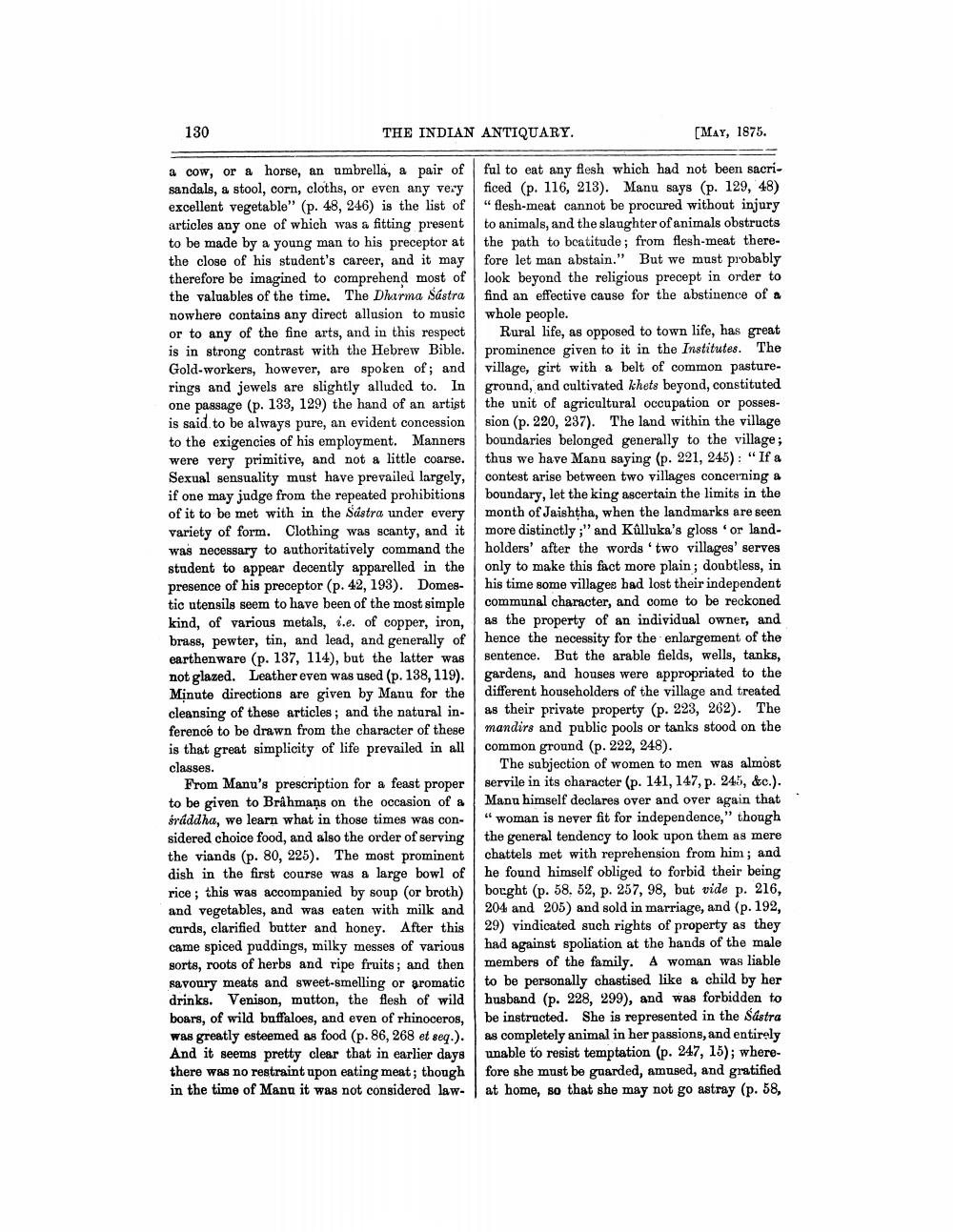________________
130
THE INDIAN ANTIQUARY.
a cow, or a horse, an umbrella, a pair of sandals, a stool, corn, cloths, or even any very excellent vegetable" (p. 48, 246) is the list of articles any one of which was a fitting present to be made by a young man to his preceptor at the close of his student's career, and it may therefore be imagined to comprehend most of the valuables of the time. The Dharma Sástra nowhere contains any direct allusion to music or to any of the fine arts, and in this respect is in strong contrast with the Hebrew Bible. Gold-workers, however, are spoken of; and rings and jewels are slightly alluded to. In one passage (p. 133, 129) the hand of an artist is said to be always pure, an evident concession to the exigencies of his employment. Manners were very primitive, and not a little coarse. Sexual sensuality must have prevailed largely, if one may judge from the repeated prohibitions of it to be met with in the Sastra under every variety of form. Clothing was scanty, and it was necessary to authoritatively command the student to appear decently apparelled in the presence of his preceptor (p. 42, 193). Domestic utensils seem to have been of the most simple kind, of various metals, i.e. of copper, iron, brass, pewter, tin, and lead, and generally of earthenware (p. 137, 114), but the latter was not glazed. Leather even was used (p. 138, 119). Minute directions are given by Manu for the cleansing of these articles; and the natural inference to be drawn from the character of these is that great simplicity of life prevailed in all classes.
From Manu's prescription for a feast proper to be given to Brâhmans on the occasion of a śráddha, we learn what in those times was considered choice food, and also the order of serving the viands (p. 80, 225). The most prominent dish in the first course was a large bowl of rice; this was accompanied by soup (or broth) and vegetables, and was eaten with milk and curds, clarified butter and honey. After this came spiced puddings, milky messes of various sorts, roots of herbs and ripe fruits; and then savoury meats and sweet-smelling or aromatic drinks. Venison, mutton, the flesh of wild boars, of wild buffaloes, and even of rhinoceros, was greatly esteemed as food (p. 86, 268 et seq.). And it seems pretty clear that in earlier days there was no restraint upon eating meat; though in the time of Mann it was not considered law
[MAY, 1875.
ful to eat any flesh which had not been sacrificed (p. 116, 213). Manu says (p. 129, 48) "flesh-meat cannot be procured without injury to animals, and the slaughter of animals obstructs the path to beatitude; from flesh-meat therefore let man abstain." But we must probably look beyond the religious precept in order to find an effective cause for the abstinence of a whole people.
Rural life, as opposed to town life, has great prominence given to it in the Institutes. The village, girt with a belt of common pastureground, and cultivated khets beyond, constituted the unit of agricultural occupation or possession (p. 220, 237). The land within the village boundaries belonged generally to the village; thus we have Manu saying (p. 221, 245): "If a contest arise between two villages concerning a boundary, let the king ascertain the limits in the month of Jaishtha, when the landmarks are seen more distinctly;" and Kûlluka's gloss or landholders' after the words 'two villages' serves only to make this fact more plain; doubtless, in his time some villages had lost their independent communal character, and come to be reckoned as the property of an individual owner, and hence the necessity for the enlargement of the sentence. But the arable fields, wells, tanks, gardens, and houses were appropriated to the different householders of the village and treated as their private property (p. 223, 262). The mandirs and public pools or tanks stood on the common ground (p. 222, 248).
The subjection of women to men was almost servile in its character (p. 141, 147, p. 245, &c.). Manu himself declares over and over again that
woman is never fit for independence," though the general tendency to look upon them as mere chattels met with reprehension from him; and he found himself obliged to forbid their being bought (p. 58. 52, p. 257, 98, but vide 216, p. 204 and 205) and sold in marriage, and (p. 192, 29) vindicated such rights of property as they had against spoliation at the hands of the male members of the family. A woman was liable to be personally chastised like a child by her husband (p. 228, 299), and was forbidden to be instructed. She is represented in the Sastra as completely animal in her passions, and entirely unable to resist temptation (p. 247, 15); wherefore she must be guarded, amused, and gratified at home, so that she may not go astray (p. 58,




